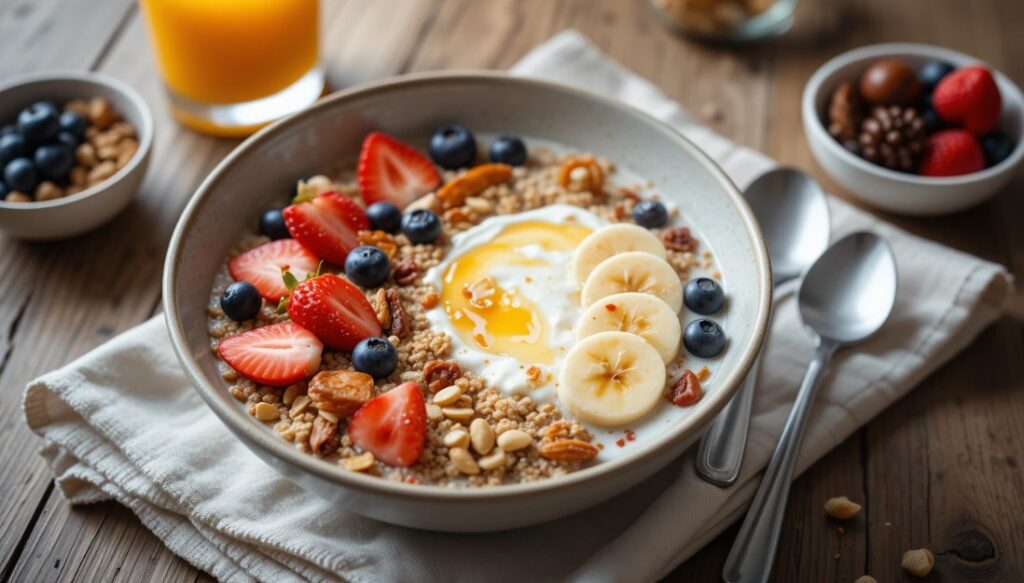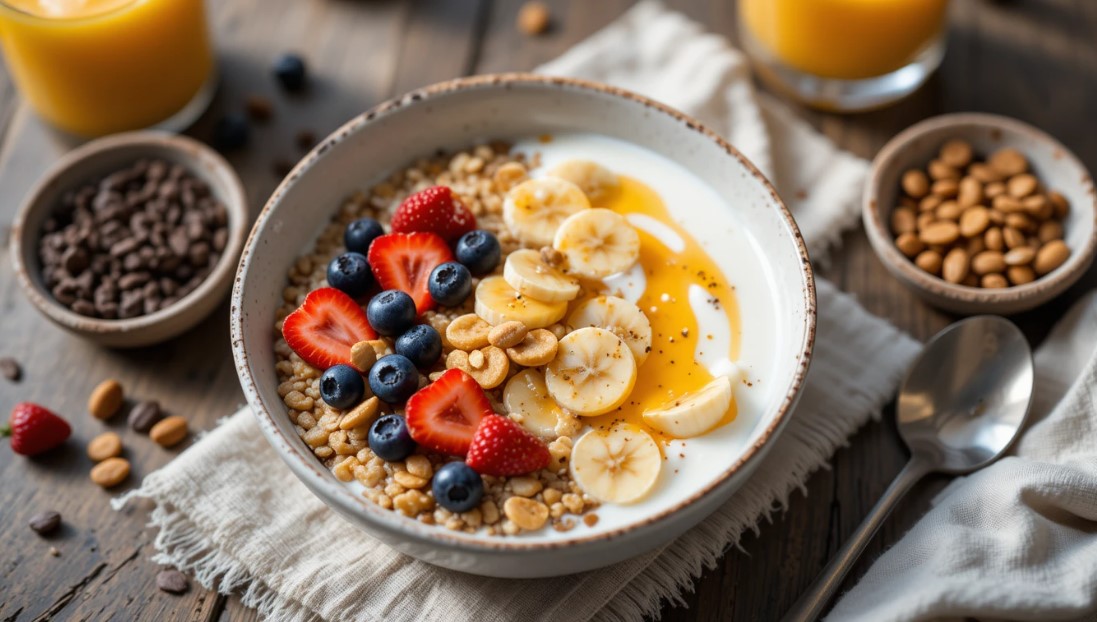Mornings can be hectic, and finding a breakfast option that is both nutritious and convenient is essential. High-fibre muesli is a perfect solution, offering a wholesome combination of whole grains, nuts, seeds, and dried fruits. Packed with dietary fibre, protein, and essential vitamins, this power-packed breakfast keeps you full and energized throughout the day. In this article, we will explore everything about high-fibre muesli, from ingredients to step-by-step recipes and expert tips.
Table of Contents
What Makes High-Fibre Muesli the Perfect Breakfast?
High-fibre muesli is a blend of raw or toasted grains, nuts, seeds, and dried fruits. Unlike granola, it does not require added sugar or oil, making it a naturally healthy choice. The combination of fibre-rich ingredients promotes digestive health, stabilizes blood sugar levels, and provides sustained energy.
The best part about high-fibre muesli is its versatility. You can enjoy it cold with milk, yogurt, or fruit juice, or prepare it as overnight oats. It can also be warmed up like porridge during colder months. No matter how you choose to eat it, high-fibre muesli is a great way to kickstart your day.
Key Ingredients for a Nutrient-Packed High-Fibre Muesli
To make high-fibre muesli at home, you need a combination of whole grains, nuts, seeds, and dried fruits. Here’s a breakdown of the best ingredients to use:
1. Whole Grains (Base of the Muesli)
- Rolled oats (rich in soluble fibre, aids digestion)
- Wheat bran (adds extra fibre and promotes gut health)
- Barley flakes (great for lowering cholesterol)
- Rye flakes (full of essential minerals and fibre)
- Quinoa flakes (high in protein and iron)
2. Nuts (Boost Protein and Healthy Fats)
- Almonds (good for heart health)
- Walnuts (rich in omega-3 fatty acids)
- Cashews (great source of magnesium)
- Pecans (loaded with antioxidants)
3. Seeds (Extra Fibre and Nutrients)
- Chia seeds (high in omega-3s and fibre)
- Flaxseeds (help in digestion and hormone balance)
- Sunflower seeds (boost immunity and skin health)
- Pumpkin seeds (rich in magnesium and zinc)
4. Dried Fruits (Natural Sweetness and Micronutrients)
- Raisins (improve iron levels)
- Dried apricots (good for eye health)
- Dried figs (high in calcium and potassium)
- Dates (natural source of energy and fibre)
Step-by-Step Guide to Making Your Own High-Fibre Muesli
Step 1: Toasting the Grains, Nuts, and Seeds
To enhance the flavor of high-fibre muesli, lightly toast the grains, nuts, and seeds. Follow these simple steps:
- Preheat your oven to 350°F (175°C).
- Spread the rolled oats, wheat bran, barley flakes, and rye flakes on a baking sheet.
- Toast for 8-10 minutes, stirring halfway through to ensure even browning.
- On a separate baking sheet, spread the nuts and seeds and toast for 5-7 minutes.
- Allow everything to cool completely before mixing.
Step 2: Adding Dried Fruits
Once the toasted ingredients are cool, transfer them to a large mixing bowl and add dried fruits of your choice. Stir well to distribute evenly.
Step 3: Storing Your High-Fibre Muesli
Store your high-fibre muesli in an airtight container at room temperature. It can last for up to one month when stored properly.

The Health Benefits of Eating High-Fibre Muesli Daily
1. Aids Digestion
High-fibre muesli is rich in insoluble fibre, which helps regulate bowel movements and prevent constipation.
2. Supports Heart Health
The nuts, seeds, and whole grains in high-fibre muesli contain heart-healthy fats and antioxidants that help reduce cholesterol levels.
3. Helps with Weight Management
The fibre content in high-fibre muesli keeps you full for longer, reducing unhealthy cravings and aiding weight loss.
4. Boosts Energy Levels
Muesli provides a slow release of energy, making it an ideal breakfast for busy mornings or pre-workout meals.
High-Fibre Muesli vs. Granola: What’s the Difference?
While both muesli and granola contain similar ingredients, they have distinct differences:
- Muesli is raw and does not contain added sugars or oils.
- Granola is baked and usually contains honey, maple syrup, or other sweeteners.
- Muesli is lighter and can be eaten raw or soaked overnight.
- Granola is crunchier and often consumed as a snack or topping.
For a healthier option, high-fibre muesli is the better choice since it has no added sugars or oils.
Best Ways to Enjoy High-Fibre Muesli for a Balanced Diet
1. Classic Muesli with Milk
Simply pour cold milk or a milk alternative over a bowl of high-fibre muesli and enjoy immediately.
2. Muesli Overnight Oats
- Mix 2/3 cup of muesli with 2/3 cup of milk or yogurt in a jar.
- Cover and refrigerate overnight.
- In the morning, top with fresh fruit and enjoy.
3. Warm Muesli Porridge
- Heat 1 cup of milk or water in a saucepan.
- Add 1/2 cup of muesli and simmer for 5 minutes, stirring occasionally.
- Serve warm with a drizzle of honey.
Creative Variations: Customizing High-Fibre Muesli to Your Taste
Customizing high-fibre muesli is simple. Here are some ideas:
- For a tropical twist: Add dried pineapple, coconut flakes, and macadamia nuts.
- For extra crunch: Mix in puffed rice or buckwheat groats.
- For a protein boost: Stir in protein powder or hemp seeds.
- For a chocolate flavor: Add cocoa nibs or dark chocolate shavings.
How to Store and Keep High-Fibre Muesli Fresh for Longer
Proper storage ensures that your high-fibre muesli stays fresh and crunchy. Follow these tips:
- Store in an airtight container to prevent moisture absorption.
- Keep in a cool, dark place away from direct sunlight.
- If adding fresh fruits or yogurt, store in the refrigerator and consume within a day.
Conclusion
High-fibre muesli is a simple yet nutritious breakfast that can be easily customized to suit individual preferences. Whether enjoyed with milk, yogurt, or as overnight oats, it provides long-lasting energy, supports digestive health, and helps with weight management. By making your own high-fibre muesli at home, you can control the ingredients and ensure a wholesome, preservative-free meal every morning. Give it a try and make high-fibre muesli a part of your daily routine!

